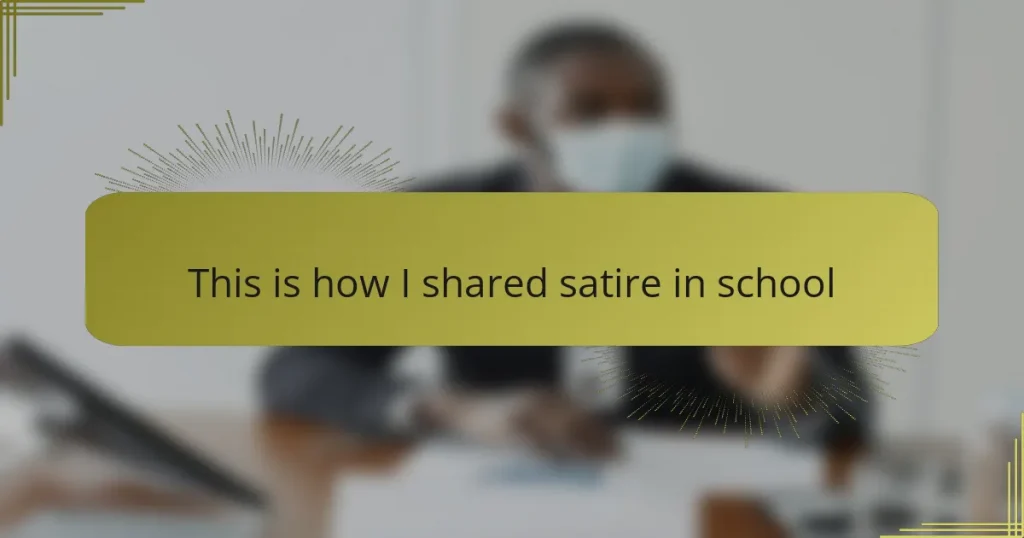Key takeaways
- Political satire awards celebrate creativity and encourage critical discourse on societal issues through humor.
- Satire in education fosters critical thinking, engagement with current events, and empathy by using humor to explore complex topics.
- Different forms of political satire, such as cartoons, articles, and skits, serve unique purposes in communicating messages effectively.
- Key criteria for effective satire include relevance, cleverness, impact, originality, and a balanced tone for meaningful critique.
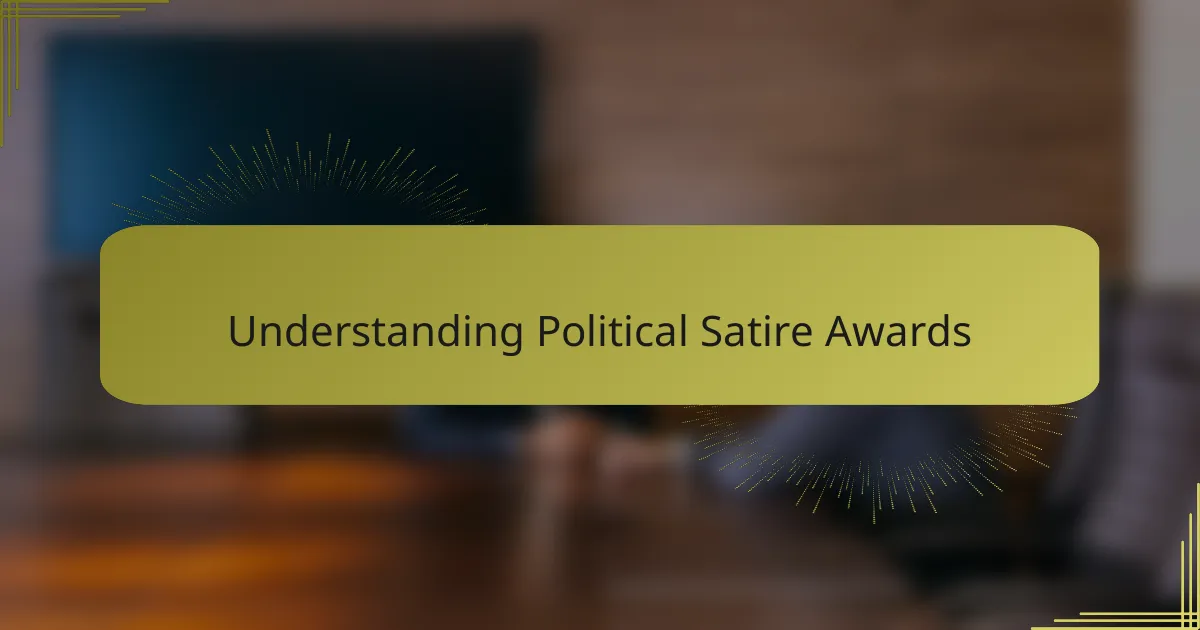
Understanding political satire awards
Understanding political satire awards can be quite enlightening. These accolades celebrate creativity and wit in critiquing political issues and figures. I remember the first time I encountered such an award—seeing talented individuals use humor as a tool for social commentary left a lasting impression on me.
By examining the effectiveness of various satirical works, we can appreciate how these awards foster a culture of accountability and reflection. They encourage creators to push boundaries and challenge norms, which is incredibly inspiring. Each award-winning piece often sparks conversations I find fascinating, as they blend humor with a sharp critique of societal issues.
- Political satire awards highlight the importance of humor in politics.
- They encourage artists to tackle complex issues with accessibility.
- Recognizing outstanding satire promotes public discourse and critical thinking.
- Award ceremonies often serve as a gathering point for new ideas and perspectives in the political landscape.
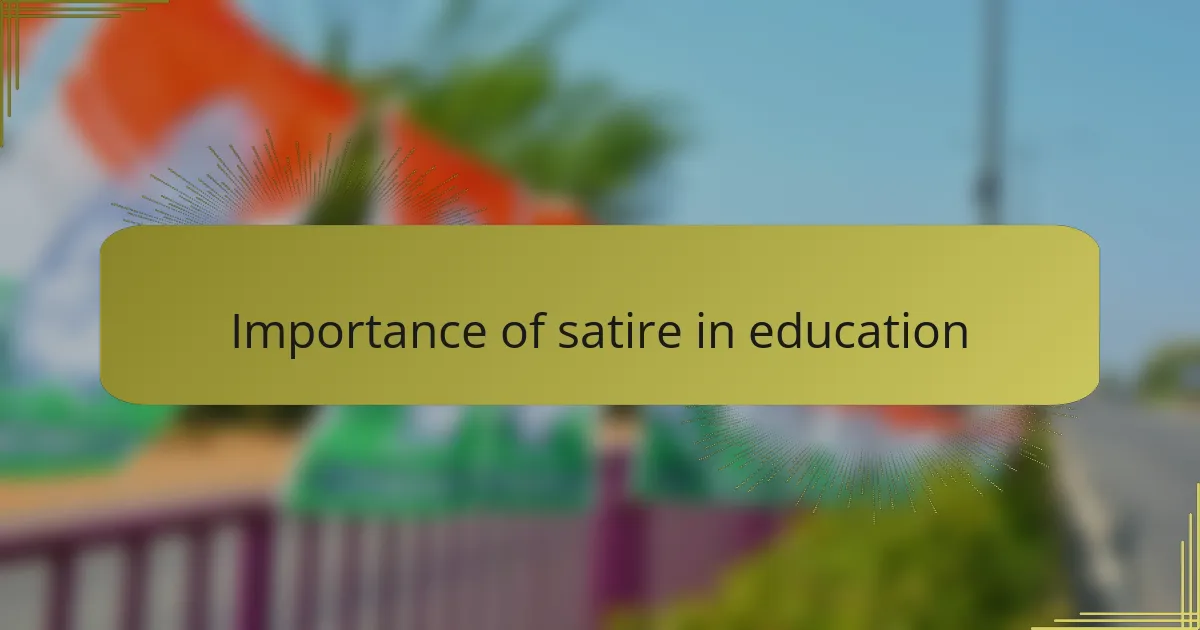
Importance of satire in education
Satire plays a crucial role in education because it encourages critical thinking. I remember my school days filled with laughter as we dissected political cartoons. Those moments didn’t just entertain; they sparked rich discussions about society and current events. It was fascinating how humor could open our eyes to serious issues.
Also, sharing satire in an educational setting helps students engage with complex topics in a relatable manner. It fosters not only a deeper understanding of political dynamics but also a sense of empathy towards different viewpoints. For instance, as we crafted our own satirical pieces, I witnessed my classmates gain confidence in expressing their opinions while pushing boundaries of traditional discussions.
Here’s a comparison of traditional educational methods and incorporating satire:
| Traditional Education | Satirical Education |
|---|---|
| Focus on rote memorization | Encourages critical thinking and creativity |
| Limited engagement with current events | Promotes discussion on real-world issues through humor |
| One-dimensional viewpoints | Explores multiple perspectives and fosters empathy |
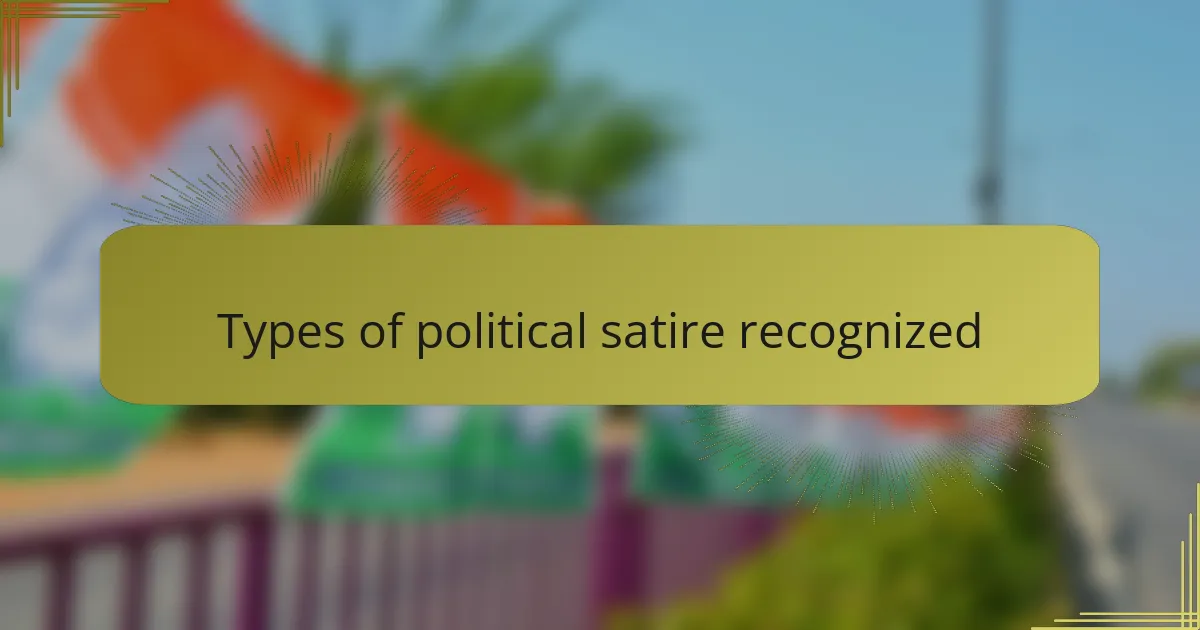
Types of political satire recognized
Political satire comes in various forms, each with its unique flavor and impact. In my experience, observing the reactions to different types has been enlightening. For instance, I noticed that satire through cartoons often hits home quickly, using visuals to encapsulate complex ideas humorously. On the other hand, satirical articles often provide a deeper dive into issues, blending humor with critical commentary that prompts the reader to think critically.
When I started sharing satire in school, I realized how powerful satire could be in the form of skits or plays. Humor on stage not only engages classmates but also creates a memorable experience that sticks with them. The reactions were always rewarding—seeing laughter turn to thoughtfulness as the punchline unfolded into a serious message.
Here’s a comparison table that highlights the different types of political satire recognized:
| Type of Satire | Description |
|---|---|
| Cartoons | Visual humor that conveys a message quickly with a punchline. |
| Articles | Written pieces offering critical perspectives wrapped in humor. |
| Skits | Live performances that blend acting and humor to engage audiences. |
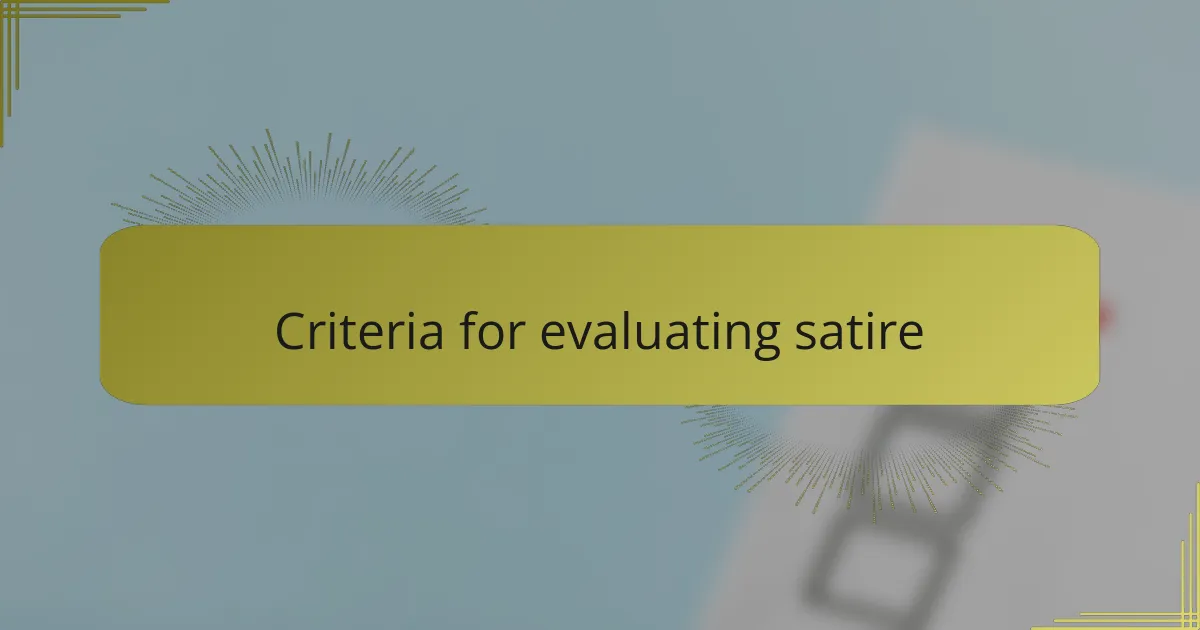
Criteria for evaluating satire
When evaluating satire, it’s essential to consider how effectively it communicates its message. I remember crafting a satirical piece during a school assignment where I used humor to highlight an absurd political issue. The reactions from my classmates, ranging from laughter to thoughtful discussion, underscored how the best satire not only entertains but also prompts reflection.
In my experience, successful satire often adheres to several key criteria:
- Relevance: Does the satire address current events or social issues that resonate with the audience?
- Cleverness: Is the language sharp and the wit insightful without being overly complex?
- Impact: Does it provoke thought or inspire action beyond just a laugh?
- Originality: Is the satirical angle unique and fresh, avoiding clichés?
- Tone: Does the tone balance humor with a serious commentary, ensuring clarity of purpose?
These elements truly transform a piece from mere jest to a meaningful critique.
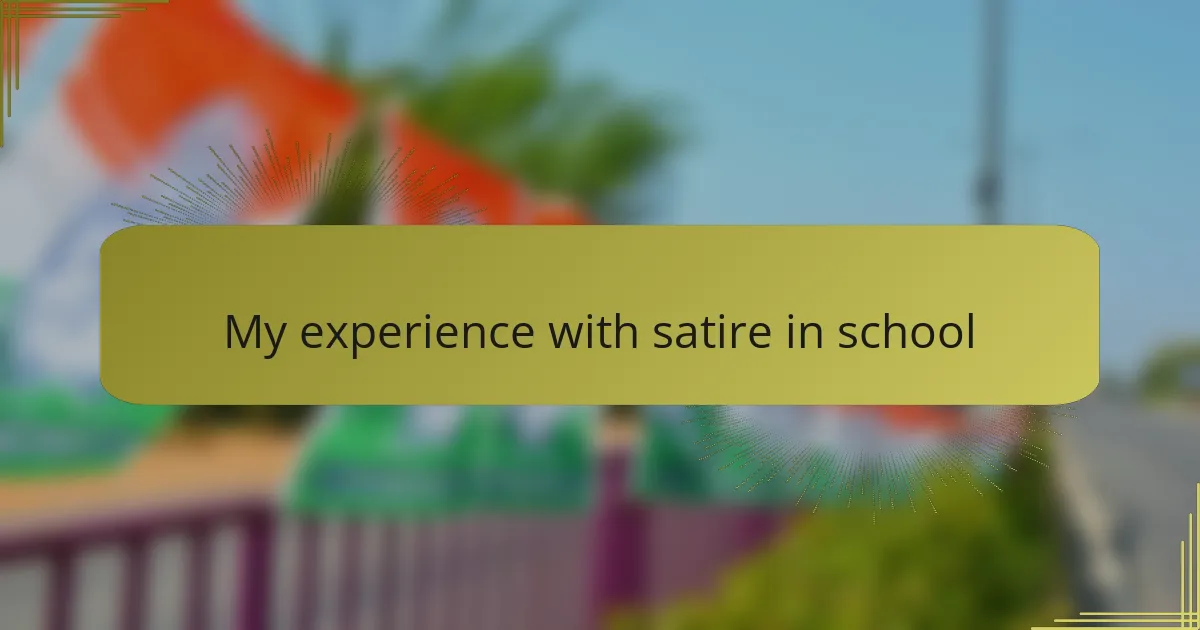
My experience with satire in school
In school, my foray into satire began with political cartoons. I remember the first time I created one; I felt a rush of excitement as I drew exaggerated features on a public figure. The laughter from my classmates was heartwarming, but it was the discussions that followed which truly captivated me. Wasn’t it fascinating how humor could illuminate the absurdities of politics?
As I evolved, so did my approach to satire. I started incorporating skits into our classroom presentations. I vividly recall one instance where we parodied a well-known debate. The absurdity of mimicking real candidates highlighted the often ridiculous nature of their arguments. Watching my peers shift from laughter to contemplation about the debate’s real issues was a magical moment for me; it sparked in me a passion for using humor to provoke thought.
I often wondered, how could something so lighthearted carry such weight? It was in sharing these moments with my classmates that I understood satire’s power. Each individual piece we created wasn’t just about the laughs—it was a shared journey towards deeper understanding, and it left a mark I still cherish today.
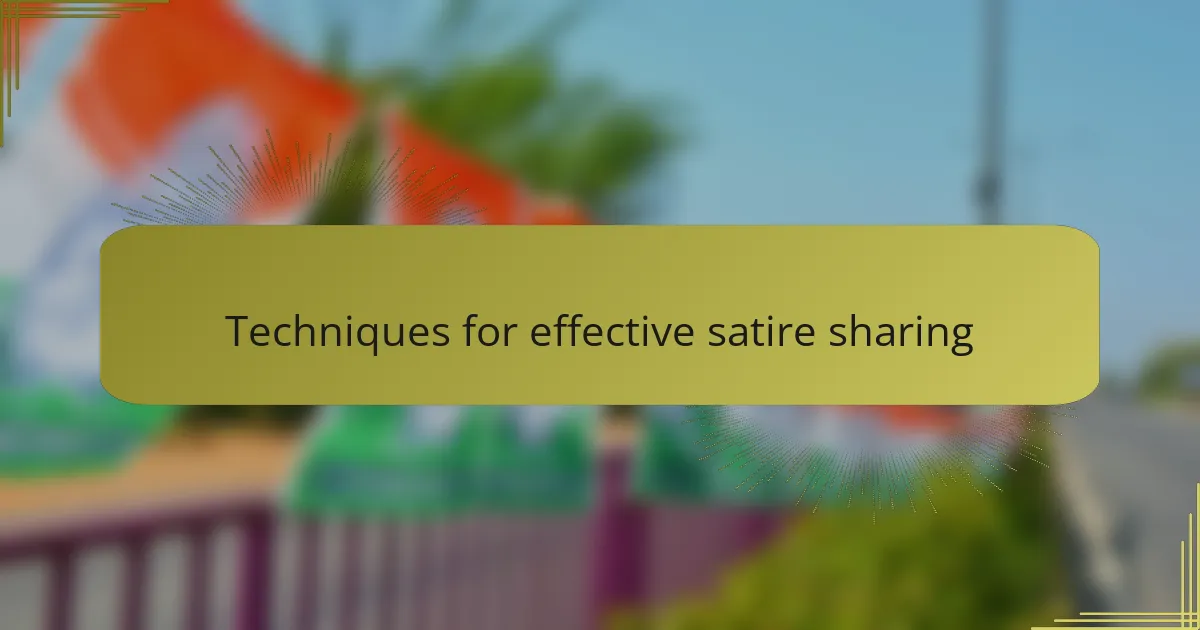
Techniques for effective satire sharing
Sharing satire effectively involves using relatable humor. I often found that embedding current events into our discussions made the topic more engaging. For instance, I remember crafting a satirical sketch about a recent political debate, and the laughter that ensued created a comfortable space for my classmates to openly share their views. Don’t you think that humor helps break down barriers?
Visuals also play a crucial role in conveying satire. I once created a cartoon that exaggerated a politician’s traits, and the immediate reactions were priceless. Everyone recognized the absurdity in the caricature, which sparked lively debates on real issues. I believe that a strong image can hit home faster than words alone. It’s fascinating how a single picture can inspire a cascade of thoughts.
Lastly, timing and delivery are essential when sharing satire. I learned this firsthand while performing skits in class. The pauses I inserted before punchlines heightened the suspense, allowing the laughter to build before delivering a serious message. Do you see how the way you present can affect the impact? Mastering these techniques turned my satire from simple jokes into powerful commentary that resonated with my peers.
